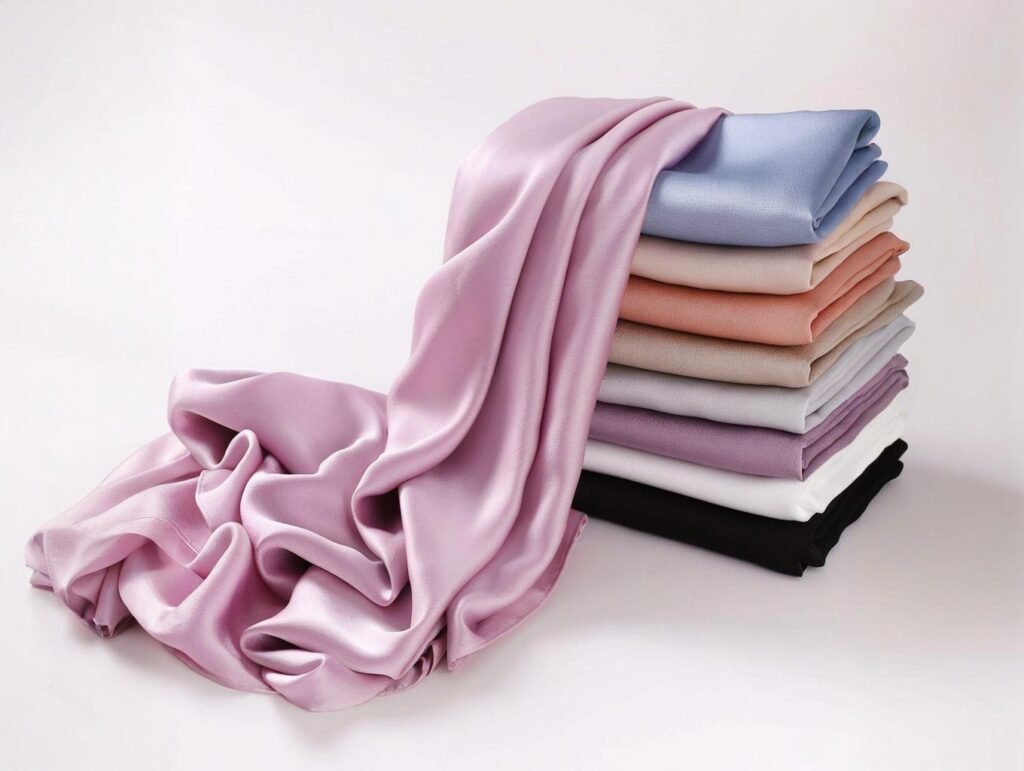In a world where consumers are drawn to luxury but brands are pressured to cut costs, the tension between natural silk and synthetic fabric alternatives sits at the heart of textile decision-making. Silk dazzles with tradition, softness, and sustainability stories. Synthetics like polyester and nylon, meanwhile, promise scale, stretch, and savings. But beneath the surface sheen and spreadsheets lies the real question: how do their production costs actually influence the final retail price tag? Silk is more expensive to produce than synthetic fabrics due to labor-intensive harvesting, limited yield, and eco-friendly processing, resulting in higher retail pricing and smaller margins.
What we’ll uncover is not just a price gap, but a strategic trade-off that affects brand positioning, product quality, and customer perception. And yes, sometimes, the cheapest fabric isn’t the most profitable.
Let’s begin by laying out the fundamental technical and performance distinctions between silk and its synthetic rivals.
What Are the Key Differences Between Silk and Synthetic Fabrics?

Silk is a natural protein fiber spun by silkworms, prized for its smooth hand feel, moisture regulation, and gentle sheen. Synthetic fabrics like polyester, nylon, and acetate, on the other hand, are petrochemical-based materials engineered for strength, stretch, and affordability. Their tactile experience, environmental behavior, and thermal performance differ significantly. Silk is a biodegradable, protein-based fiber with natural breathability and sheen, while synthetics are petroleum-derived, less breathable, but more cost-efficient and durable.
Silk vs Synthetic – Performance & Property Comparison
Core Technical Characteristics
| Property | Silk | Polyester/Nylon |
|---|---|---|
| Source | Natural (silkworm) | Synthetic (crude oil derivative) |
| Feel | Soft, smooth, breathable | Smooth but less breathable |
| Moisture Management | Excellent (wicks naturally) | Traps moisture (unless treated) |
| Elasticity | Limited stretch | High elasticity (esp. spandex blends) |
| Sheen | Natural, elegant glow | Artificial shine |
| Drape | Luxurious, fluid | Varies – often stiffer unless blended |
| Heat Resistance | Sensitive to high temperatures | More heat-resistant |
| Biodegradability | 100% (if untreated) | Very slow (takes 200–500 years) |
Use-Case Implications
- Silk is often used for lingerie, scarves, couture, bridalwear, and skin-contact garments.
- Synthetics dominate in sportswear, uniforms, bags, linings, and mass-market fashion.
Consumer Psychology
According to a 2023 consumer fabric perception study by McKinsey:
- 68% associated silk with luxury and softness
- 54% preferred synthetics for ease of care and affordability
How Is Natural Silk Produced Compared to Synthetics Like Polyester or Nylon?
Silk production is a labor- and time-intensive biological process involving the cultivation of silkworms (Bombyx mori), harvesting of cocoons, and delicate reeling and weaving. Synthetic fabrics are created through industrial chemical polymerization, where crude oil is refined into filaments, extruded, and woven into textiles. Silk is produced by cultivating silkworms and harvesting cocoons, while synthetics are made from petroleum through polymerization and high-speed extrusion—cheaper, faster, and more scalable.
Side-by-Side Production Breakdown
Silk Production Process Overview
- Mulberry cultivation for silkworm feeding
- Silkworm rearing (30–40 days)
- Cocoon harvesting
- Cocoon steaming/boiling (traditional silk) or moth release (peace silk)
- Reeling and twisting of fibers
- Weaving and dyeing
- Finishing (enzymatic softening, calendaring, etc.)
Synthetic Fabric Production Process
- Crude oil refinement into monomers
- Polymerization into polyester/nylon pellets
- Melt spinning or extrusion into filaments
- Texturizing and cutting
- Weaving or knitting
- Dyeing (often with heat-set dyes)
- Chemical finishing (anti-pilling, wrinkle-free, flame-retardant)
Environmental & Labor Comparison Table
| Metric | Silk | Synthetics (e.g., Polyester) |
|---|---|---|
| Production Time (avg. per kg) | 45–60 days | < 24 hours |
| Human Labor Involvement | High (especially rural areas) | Low (mostly automated) |
| Water Usage | High (especially in dyeing) | Lower, but often includes microplastic pollution |
| CO₂ Emissions (per kg) | ~5.0 kg CO₂e | ~9.5–11 kg CO₂e |
| Wastewater Impact | Depends on degumming/dyeing | Can be high due to finishing agents |
| Scalability | Limited by sericulture cycles | Extremely high |
Real-World Manufacturer Insight
One Southeast Asian silk producer interviewed by TextileExchange shared:
“To produce 1kg of raw silk, we need about 6,000 cocoons. It’s not scalable like polyester, but that’s what gives it value. Every meter carries labor, time, and skill.”
What Are the Average Production Costs for Silk vs Synthetic Textiles?

The production cost of silk is significantly higher than that of synthetic fabrics. This cost difference stems from the manual labor, longer production cycles, lower yield per input, and environmental controls required in silk making. In contrast, synthetic textiles like polyester and nylon benefit from automation, mass scalability, and inexpensive raw materials. Silk costs $18–$45 per meter to produce, while synthetics like polyester cost as little as $1–$5 per meter due to cheaper materials, faster production, and automation.
Cost Breakdown by Fabric Type
Average Fabric Production Costs (per meter, USD)
| Fabric Type | Raw Material Cost | Processing Cost | Total Cost |
|---|---|---|---|
| Raw Mulberry Silk (undegummed) | $9–12 | $6–10 | $15–22 |
| Silk Charmeuse (22 momme) | $14–18 | $10–15 | $24–33 |
| Polyester (basic woven) | $0.60–1.00 | $1.00–2.50 | $1.60–3.50 |
| Nylon (woven/spandex blend) | $1.20–2.50 | $2.00–3.50 | $3.20–6.00 |
| Recycled Polyester (rPET) | $1.80–2.80 | $2.50–3.50 | $4.30–6.30 |
Why Is Silk So Expensive?
- Biological yield limits: ~5,500–6,000 cocoons needed for 1 kg of silk
- Labor-intensive: Most reeling still done by hand or semi-manual machines
- Low economies of scale: Even industrial silk farms can’t match the speed of polyester extrusion
- Storage and transport sensitivity: Silk requires careful climate-controlled handling
Case Example
A luxury blouse made from 2.5 meters of 22 momme silk may cost $75–90 in fabric alone, while the same blouse made from polyester satin costs $7–9. That difference drives every downstream decision—from retail markup to target market.
Do Raw Material and Energy Inputs Affect Fabric Price Margins?
Yes. Raw material and energy inputs are key determinants of base fabric pricing and significantly affect margins across the supply chain. For silk, high costs come from land use for mulberry cultivation, worm care, manual reeling, and low yield per unit weight. For synthetics, costs are dominated by oil-based feedstock, electricity use, and industrial machinery operation. Silk’s raw material costs and energy inputs are higher due to biological constraints, while synthetics use cheaper oil-based inputs and benefit from energy-efficient mass production.
Cost and Energy Inputs by Source
Raw Material Input Comparison
| Input Factor | Silk | Synthetic (Polyester/Nylon) |
|---|---|---|
| Base Material | Silkworm cocoons | Petrochemicals (crude oil, ethylene) |
| Land Usage | High (sericulture + mulberry) | Very low (factory-produced) |
| Feed/Resource Input | Mulberry leaves (~25 kg/kg silk) | None |
| Biodegradable | Yes (100%) | No (200–500 years to degrade) |
| Carbon Offset Potential | High (renewable agriculture) | Low (fossil-based source) |
Energy Use Comparison (Per Kg of Fabric Produced)
| Energy Use Stage | Silk (kWh/kg) | Polyester (kWh/kg) |
|---|---|---|
| Raw Material Production | 5.5–7.0 | 2.0–2.5 |
| Processing/Reeling | 4.5–6.0 | 1.5–2.5 |
| Finishing & Dyeing | 3.0–4.0 | 2.5–3.0 |
| Total | 13–17 kWh | 6–8 kWh |
Margin Impact
Because of these energy and material demands, the starting cost per kilogram of silk is often 5x–10x higher than polyester. This directly affects:
- Product pricing
- Waste costs
- Sustainability reporting
- Carbon disclosure scores
Strategic Insight
Some brands leverage silk’s high input cost as a storytelling asset: “Our fabric is grown, not made.” Others use synthetics for cost control but offset their impact with carbon credits or recycled sources to appease sustainability-conscious consumers.
How Do Labor and Processing Costs Influence Final Fabric Pricing?

Labor and processing costs are pivotal in determining the final price of both silk and synthetic fabrics—but they weigh more heavily in natural silk production, where human skill and time are irreplaceable. In contrast, synthetic fabrics rely on machinery and mass automation, lowering the cost per unit but increasing capital infrastructure and energy demand. Silk’s pricing is heavily influenced by manual labor and slow processing, while synthetics benefit from automation and faster output, resulting in lower overall labor costs.
Human vs Machine – Processing Cost Drivers
Silk Labor Intensity
- Cocoon sorting and reeling often done by hand in rural areas
- Skilled artisans required for filament preservation and quality consistency
- Small-batch dyeing processes often manual or semi-automatic
- Post-weaving finishing steps like calendaring or sand washing are time-consuming
Synthetic Labor Profile
- Industrial scale operations with computer-controlled melt spinning
- Fully automated dye jets and finishing tunnels
- Minimal labor input after setup
- Lower risk of quality variation due to machine standardization
Processing Cost Comparison (USD/kg)
| Step | Silk (Manual/Hybrid) | Polyester (Industrial) |
|---|---|---|
| Reeling/Extrusion | $4.00–6.00 | $0.60–1.00 |
| Dyeing | $2.50–4.00 | $1.00–1.80 |
| Finishing | $2.00–3.50 | $0.80–1.50 |
| Total Processing Cost | $8.50–13.50 | $2.40–4.30 |
Brand Case Study
A French fashion house producing 500 units of silk blouses in India reported that labor accounted for 38% of total fabric cost. In comparison, a fast fashion retailer using polyester knits in China allocated only 12% of fabric cost to labor.
Silk pricing is labor-dominated; synthetic pricing is volume-driven. This distinction influences not just product costs, but ethical sourcing, employment strategy, and brand storytelling.
Is There a Quality Trade-Off When Choosing Synthetic Over Silk?
Yes—and it’s not just physical. While synthetics can mimic silk’s look, they often fall short in breathability, moisture management, and skin feel. Silk offers unmatched temperature regulation, softness, and elegance, whereas synthetics trade that for durability, stretch, and price efficiency. Silk offers superior comfort and elegance, while synthetics sacrifice touch and breathability for lower cost, increased durability, and easier maintenance.
Fabric Behavior & Consumer Experience
Comparison of Key Quality Attributes
| Attribute | Silk | Synthetic Alternatives (Poly/Nylon) |
|---|---|---|
| Hand Feel | Soft, buttery, breathable | Smooth but artificial |
| Drape | Natural and fluid | Often crisp or bouncy unless blended |
| Color Depth | Rich with natural luminosity | Saturated but flat shine |
| Skin Sensitivity | Hypoallergenic | Can cause irritation (esp. when heat-sealed) |
| Wrinkle Resistance | Wrinkles easily | Often wrinkle-free |
| Durability (Washing) | Fragile in machine washes | High resistance to abrasion |
| Maintenance | Requires delicate care | Easy care, fast-dry, low iron |
Real-World Retail Outcome
An e-commerce brand A/B tested two identical blouse designs, one in silk and one in polyester satin. The silk version had a 30% higher return rate due to care complexity, but the customers who kept it left 2x more positive reviews about comfort and elegance—supporting a premium pricing strategy and repeat purchase loyalty.
Thought Perspective
While synthetics win on function and price, silk wins on experience. For brands selling intimacy, luxury, or sustainability, that emotional edge can justify the cost difference—if the consumer understands the story.
Which Factors Most Influence Retail Pricing for Silk and Its Alternatives?

Retail pricing is influenced by more than just base material cost. Factors like brand positioning, perceived value, target customer, and supply chain choices all contribute. While silk commands a higher price due to its origin and sensory appeal, synthetics often offer better margin control due to low costs and scalable supply. Retail pricing for silk is shaped by material cost, exclusivity, and luxury perception, while synthetic pricing is driven by volume, functionality, and price sensitivity.
Retail Pricing Framework
Key Pricing Drivers by Fabric Type
| Factor | Silk | Synthetic Alternatives |
|---|---|---|
| Fabric Cost (raw) | High ($18–$45/meter) | Low ($1.5–$6/meter) |
| Brand Positioning | Luxury, sustainable, heritage | Value-driven, performance, trend |
| Storytelling Value | High (artisanal, ethical) | Low to moderate (tech-based) |
| Target Customer | Discerning, quality-first | Price-sensitive, fast-fashion |
| Maintenance Perception | Requires care | Easy care, machine washable |
| Markup Potential | 3x–5x base cost (exclusive) | 5x–8x base cost (mass retail) |
Real-World Example
A U.S.-based brand launched two sleepwear sets:
- Silk version: $190 retail, 42% margin, 4.9-star reviews
- Satin (polyester) version: $69 retail, 63% margin, 3.8-star reviews
While the synthetic version had higher initial volume, the silk version led to higher repeat purchases and was frequently gifted, increasing lifetime customer value.
How Should Brands Decide Between Using Silk or Synthetics for Their Products?
The decision depends on design goals, audience expectations, pricing model, and supply chain priorities. Silk may suit luxury or sustainability-focused collections, while synthetics can serve better in performance-driven, cost-conscious, or trend-sensitive lines. The smartest brands often integrate both, choosing silk for hero items and synthetics for volume-based SKUs. Brands should choose silk for premium, tactile, or story-driven pieces, and synthetics for scale, price flexibility, and technical apparel—balancing brand message and margin.
Decision-Making Framework
Use-Case Matrix: Silk vs Synthetic by Brand Strategy
| Brand Goal | Better Choice | Why |
|---|---|---|
| Launching a high-end capsule | Silk | Luxurious texture + exclusivity |
| Expanding into athleisure | Synthetic | Stretch, durability, sweat management |
| Storytelling around sustainability | Silk (esp. Ahimsa) | Natural, traceable, biodegradable |
| Reducing cost of goods sold | Synthetic | Better margin, easier supply chain control |
| Creating occasionwear | Silk or satin blends | Sheen and drape critical |
| Targeting Gen Z fast fashion | Synthetic | Price point and trend cycle responsiveness |
Designer Insight
“Not every piece has to be silk. But one silk garment in your collection can elevate your whole brand,” says a creative director of an eco-luxury brand in London.
Work with a Trusted Silk Fabric Supplier
At SzoneierFabrics, we offer custom solutions in both silk and synthetic fabric categories, tailored to your brand’s goals. Whether you’re launching a capsule collection or scaling production with affordability in mind, we help you find the right balance between cost, quality, and sustainability.
What we offer:
- 100% mulberry silk, organic silk, satin blends, and synthetic alternatives
- Low-MOQ sampling and custom dyeing
- GOTS, OEKO-TEX, and REACH-compliant materials
- Free swatches, fast turnaround, and full quality assurance
- Custom labeling and private logo support
Contact SzoneierFabrics today to get free samples or request a custom quote for your next silk or synthetic fabric project.
Your fabric should match your story. Let’s create it together.

